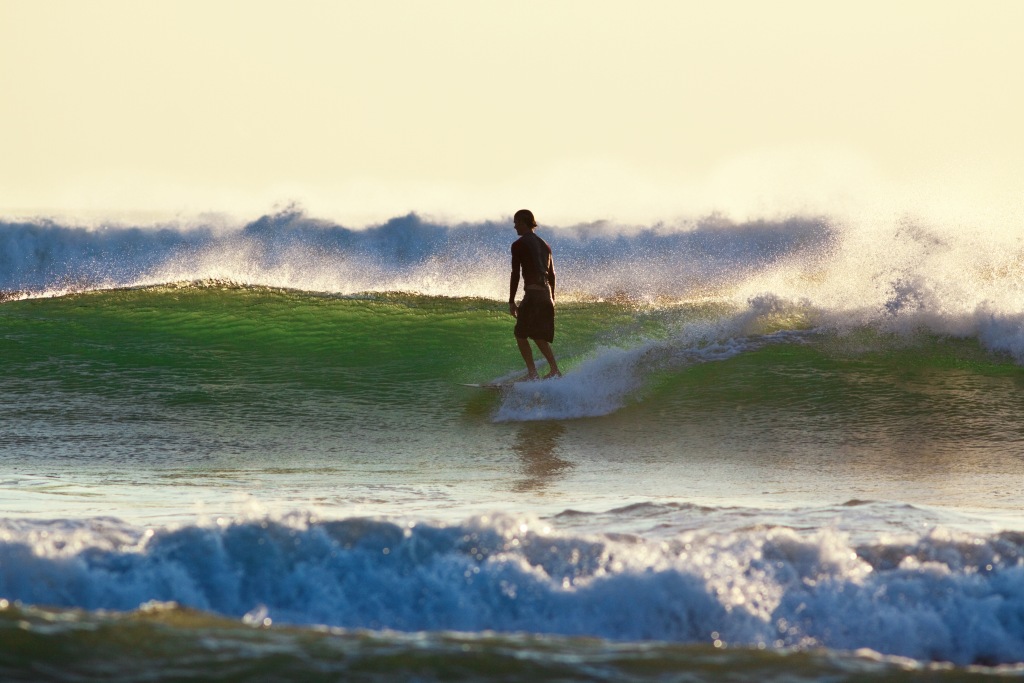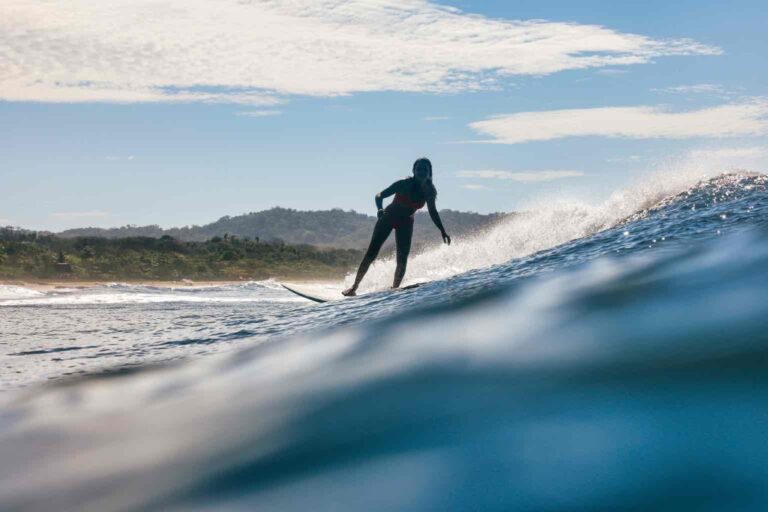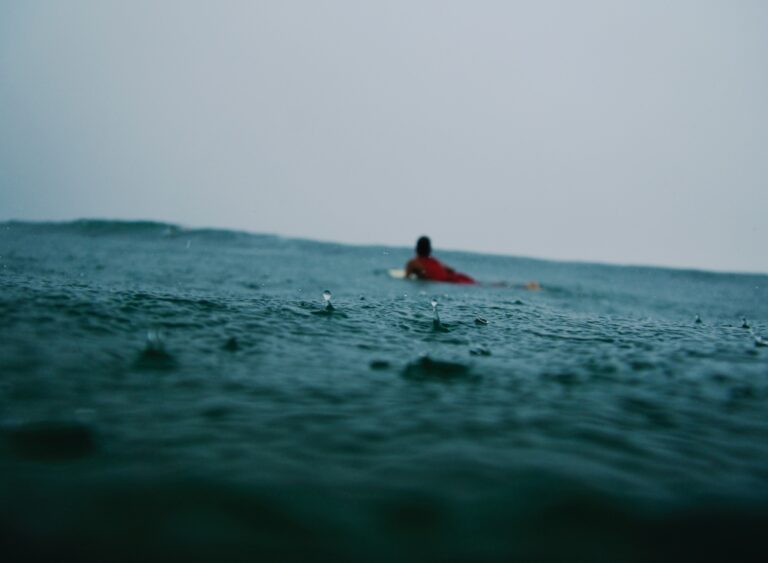Playa Grande Surf Guide
About 25 minutes north of Guanacaste’s more famous surf town Tamarindo, you’ll find Playa Grande- one of the most high quality, powerful, and consistent waves on Costa Rica’s Nicoya Peninsula.
In the summer months of Costa Rica, between December and April, Playa Grande boasts consistent surf that’s doable for all levels of surfers, although the main break does bode better for shortboards since it’s so powerful.
Despite high-quality waves, navigating the Playa Grande surf scene can be tricky. This surf break has far more localism than any other surf spots in Costa Rica I’ve been to, and the area is also brimming with wildlife.
With that said, Playa Grande is still a beautiful area, and home to some excellent waves- if you dare to brave the lineup!
Playa Grande surf overview
Playa Grande is a small surf town north of Tamarindo, just under a 2 hour drive from Liberia. The beach at Playa Grande is three miles long, and a part of the Las Baulas National Marine Park, where leatherback turtles come to nest. When there is a huge swell, you can surf all along the beach in Playa Grande. When there’s not a big swell, you can still enjoy surfing the primary surf breaks of Playa Grande.
** This article contains affiliate links. As an Amazon Associate, I earn from qualifying purchases. Meaning, at no extra cost to you, I earn a small commission anytime you purchase any of the linked products. Thanks for your support of Gathering Waves!
The different Playa Grande surf breaks

Main Break
You’ll find the main break of Playa Grande just south of the beach access point at Hotel Las Tortugas. The wave breaks both left and right, and depending on the tide, barrels. The main break of Playa Grande is super steep, fast, and heavy. While you can take longer boards out, the break is much more suited to shortboards- especially if you’re sitting right at the peak. The wave breaks on a sandbar. If you’re hoping to catch some of the best waves at Playa Grande, you’ll have to be patient. This surf break is heavily localized, and the locals are very protective of their wave. Drop-ins are common, and if you paddle out in a group, you might get some lip from one of the locals. The wave here is super nice, but it definitely comes with some drama.
Palm Beach Estate Peaks
Palm Beach Estates is a bougie neighborhood/ gated community that runs adjacent to Playa Grande, starting just south of the Main Break and running all the way to the estuary. When there is a decent amount of swell in the water, there are breaks all along the beach in this area, but they don’t hold up as nicely as the main break or as nicely as Casitas.
Casitas
Casitas is located just north of the rivermouth, in front of a cluster of small houses, aka casitas. This Playa Grande surf break has a bit mellower vibe, and is also softer and better for longboarders.
Where to stay for a Playa Grande surf trip

Onda is located mere steps away from the main break of Playa Grande. They offer a surf camp which includes breakfast, accommodations, all surf gear, airport transfer, 5 surf lessons, surf seminars, and surf video analysis.
The surf house itself is beautiful, with a huge pool, plenty of space to relax, and a large common area. If you’re looking for a fun surf trip to Playa Grande, definitely check out Onda.
If you’re on a budget, I recommend checking out Playa Negra Surf Camp. It’s a really nice hostel with a mix of dorms and private rooms, a pool, and a restaurant. It’s located within the Palm Beach Estates neighborhood, so it’s super safe too.
Best swell for Playa Grande
Playa Grande performs best with a solid SW swell.
Playa Grande surf seasons
*in this section you can discuss which season(s) are best for surfing in Arugam Bay, and briefly touch on the other season as well
Dry Season
The dry season runs from December-April, and this is when the waves are small and clean. This is a good time to come surf at Playa Grande if you want sunny days, smaller waves, and fun, clean surf.
Rainy Season
The rainy season runs from May-November, and this is when the waves are bigger, crowds are fewer, and swells are much more frequent. This is a good time to plan a surf trip to Playa Grande if you don’t mind a bit of rain and want to surf some bigger waves.
Playa Grande FAQ’s
Is Playa Grande safe?
Aside from petty theft and the occasional crocodile sighting, Playa Grande is pretty safe.
Is Playa Grande a good surf town for beginners?
No. If you’re a beginner, I recommend heading south to Tamarindo, Playa Avellanas, or one of the other best beginner surf spots in Costa Rica.
Hazards of surfing at Playa Grande
Heavy waves
When the surf is on, the waves at the main break of Playa Grande break pretty heavy.
Aggressive locals
Out of everywhere I’ve surfed in Costa Rica, Playa Grande has been the only place with super aggressive locals. It’s not just me either- my Costa Rican friends who live in Nosara don’t really like surfing in Playa Grande because of the local vibe.
Getting your car broken into
Car break-ins are a huge problem in Playa Grande. Don’t leave ANYTHING of value in your car there, including surfboards on the roof.
Sharks & Crocs
Playa Grande is located right next to the estuary and a river mouth- a wonderful habitat for both crocs AND sharks. When we were in Playa Grande, we even saw a 6 foot shark swimming in the surf. Apparently, after talking to some locals, this is a very common occurrence. Take extra care too if you’re surfing near the rivermouth!
Playa Grande surf guide- final thoughts
That’s a wrap on my Playa Grande surf guide! If you’re looking for a super high-quality wave and don’t mind a bit of an aggressive local vibe, you’ll probably have a blast surfing here.
If that doesn’t quite sound like your thing, I recommend checking out some of Playa Grande’s more mellow neighbors, like Playa Avellanas, Playa Tamarindo, and Playa Guiones in Nosara.
If you enjoyed this surf guide, head on over to my FREE Facebook Group, Surf Travel Tribe. In the group, I share more free surf travel content, and help you plan your next surf trip.
Happy Surfing!





